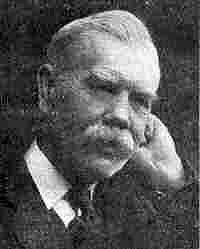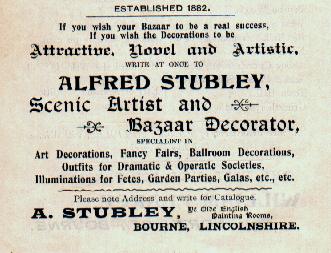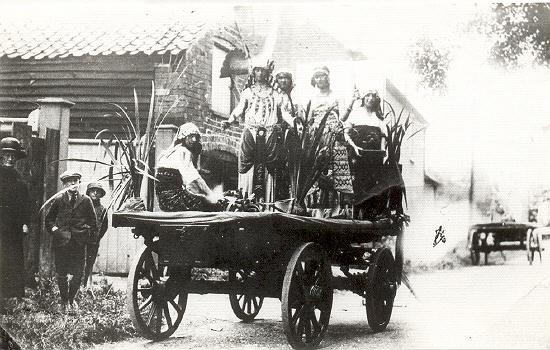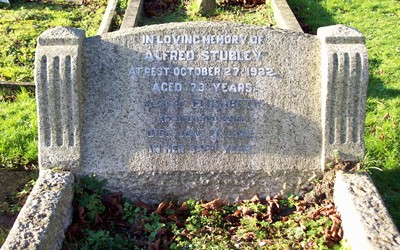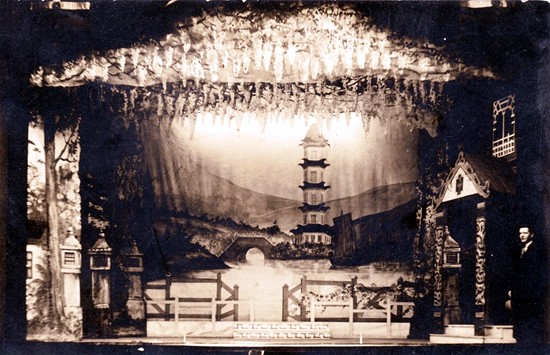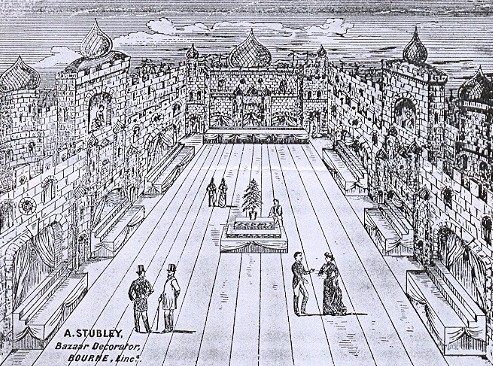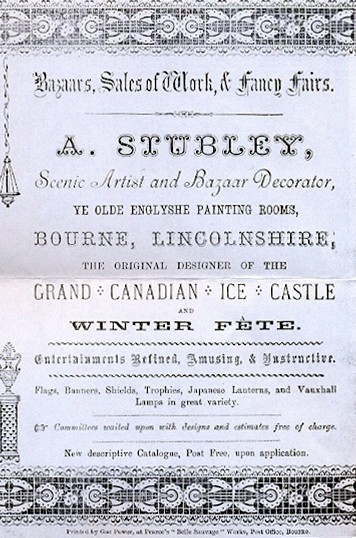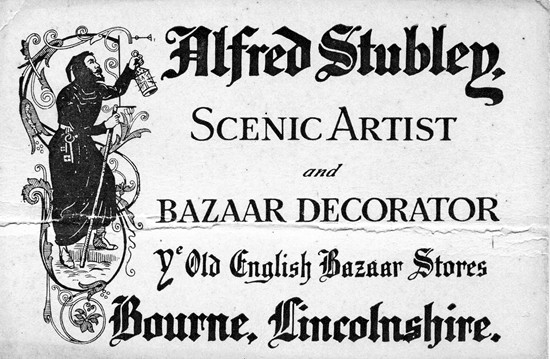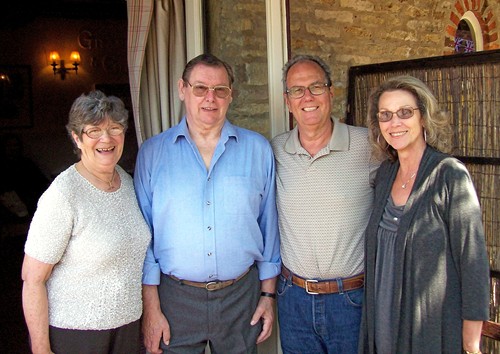During the years before television, Alfred Stubley brought make believe to many during his career as a scenic artist, using his vivid imagination to produce stage sets for a wide variety of social events and amateur theatrical presentations in Bourne and the surrounding towns. His name became so well known in the county and beyond that the following tribute appeared in a feature on Bourne published by the Lincolnshire Gazette in 1924 in a series entitled Lincolnshire Town and Village Life written by H Green: Mr Stubley, the scenic artist is known all over England for his bazaar productions. We have seen his magic change the dull formal interior of a corn exchange or drill hall into a garden of Japan, a street in Sunny Spain or a palace of ice stalactites. His studio is a picturesque being in itself and it is a fascinating experience to look through his warehouses in which are stored away old English, Norman, Flemish and all manner of representations of former and latter day architecture side by side, as well as to meet the courteous producer of it all. One of his notable successes was at Christmas in 1887 when he designed the sets for a grand fancy fair, similar to our modern pantomimes, which was staged at the Corn Exchange shortly after Boxing Day to raise funds for the Congregational Church in Eastgate [now the United Reformed Church] and the hall had been decorated as a street of nations or a grand international bazaar, with oriental and European architecture. The Stamford Mercury printed a description of the colourful setting: The scene was laid in Canton. The peculiar conglomeration of Oriental and European architecture was depicted with realistic effect. Proceeding down the left side of the street, the enterprising traveller passed in succession a Persian residence, an Indian cottage, a Chinese house, a delightful Japanese village, a Tyrolese chalet, a snug mountain home covered with snow and having icicles pendent from the roof, a magnificent Buddhist temple having its elaborate exterior embellished with representatives of the Oriental deity and dragons, and the last abode in the curious street was an Australian log hut. The articles exhibited on the various stalls were both useful and ornamental. Various entertainments were given in the evenings. Vocal and instrumental musical items and presentations were performed at intervals which were very popular. The promoters of the enterprise are to be congratulated on the success which has deservedly crowned their efforts. Another major triumph came the following year when he designed the sets for the Grand Bazaar, also held in the Corn Exchange, on Monday and Tuesday, the 28th and 29th May 1888, when the room was adorned with his colourful banners and the walls covered with his various designs. The event was a spectacular success and the Stamford Mercury reported: The interior of the hall presented a pleasing appearance. The roof was festooned with banners and the walls were adorned with ornamental devices. Mr Alfred Stubley undertook the decorations and the stalls were visions of beauty. There were many other examples of his art and whenever a local production or bazaar was being held, Alfred Stubley’s imagination was invariably at work to make the event a success. His help was particularly valued by local musical and drama groups such as the Bourne Amateur Operatic Society which presented annual performances at the Corn Exchange in the early years of the 20th century with his stage sets.
Oliver Alfred Stubley was born in the town
on 17th March 1859, son of farmer William Stubley and his wife Mary
Ann. He attended the council school
before learning his trade as a painter and decorator and soon established
his business at 28 West Street where he lived with his family, working
from the workshops and warehouses at the rear, now all demolished. He
earned his living painting, paper hanging, sign writing and plumbing but his
private passion
was the theatre and few stage productions, bazaars or big social occasions
in the town did not bear his mark. The presentations he created for bazaars became so popular that he published a 22-page illustrated advertising booklet describing them for the benefit of interested committees and printed by John Pearce at his Belle Sauvage Works behind the Post Office in North Street. It contained details of his achievements and a series of press notices and testimonials to his work with the announcement:
Committees and those interested in bazaar work
would do well before arranging their winter Sale of Work to send for our
Catalogue. We should also be pleased to wait upon Committees at any time,
free of charge, with a selection of designs and estimates, when we feel
sure, such inducements can be offered, both financially and decoratively
as cannot fail to meet with their approval. Mr Stubley suffered a serious setback in 1897 when his workshop was destroyed by fire. The outbreak occurred soon after lunchtime on Wednesday 30th June and as the building was made of wood and contained a great deal of inflammable material, the flames soon spread to the Baptist Church which was almost next door. The greater portion of Mr Stubley's valuable scenery was stored in a building adjoining which was not affected but the church interior was badly damaged. Ironically, Mr Stubley was also a dedicated churchman who worshipped at the Baptist Church. In July 1924, when the church celebrated its centenary, he was honoured for his work with the Sunday School with which he had been associated for 50 years and was presented with the diploma of the National Sunday School Union and a Jacobean oak table from the congregation in recognition of his dedicated service. Equally distinguished were his 50 years as choirmaster at the church and his love of music inspired him to form the Bourne Town Band in 1887 after appealing for support with a notice in the local newspaper, becoming the first conductor until succeeded by Mr F J Clarke. He was also a member of Bourne Parish Council which came into being as a result of the Local Government Act of 1894 and functioned until 1898 when its duties passed to Bourne Urban District Council although he never tried to obtain a seat on the new authority. During his time as a parish councillor, it was his insistence and technical ability which led to the installation of an illuminated clock on the front of the Town Hall. In May 1880, he married farmer's daughter Elizabeth Walker, of Wansford, near Peterborough, and they had eleven children, seven girls and four boys, Nell (1881), Lilian (1882), Ethel (1884), Hilda (1886), Ida (1888), Alfred Ernest (1891), Fred (1893), Cecil Henry (1896), Kathleen Elizabeth (1898), John Oliver (1902) and Marie Phyllis (1906). Hilda married Horace Hassock and emigrated to Australia, Alfred emigrated to Canada while the others remained in Bourne where the Stubley name still survives.
Mr Stubley died in the autumn of 1932, aged 73. He had been in failing health for some time and was admitted to St Peter's Hospital, London, where a minor operation was performed in the hope that he could withstand major surgery later on and although he rallied for a while, his condition deteriorated and he died on Thursday 27th October. His body was brought back to Bourne the following Saturday for the funeral service at the Baptist Church he loved when his favourite hymns, Jesus shall reign where e’re the sun, I do not ask, O Lord, O love that will not let me go and The day thou gavest Lord is ended, were sung by choir and congregation in his memory. The town turned out to pay tribute and the following day, Sunday, a memorial service was held to honour the man who had brought joy to so many. The Rev A W Gunstone, who conducted the funeral service, said that he had fulfilled his life in many ways, as a husband and father, and as someone who had given so much time to provide pleasure for the community.
Four deacons from the church carried the coffin for his burial in the town cemetery and a mass of flowers were laid on his grave where his wife, Elizabeth, who survived him until 20th January 1952 when she died, aged 94, is also buried. A final eulogy to his work appeared in the Lincolnshire Free Press soon after he died, a newspaper which he suggested had been the catalyst for his success. Their issue of 27th October 1932 which carried his funeral notice, said: Mr Stubley's capabilities as a scenic artist were as great as his talent in matters musical and it was his proud boast that it was a report in this newspaper of a bazaar at Spalding nearly fifty years ago which first set his feet on the road to success in this connection. He was known almost the country over as an expert scene painter and to him had been allotted the task of preparing suitable scenery at bazaars and similar functions in nearly every part of the United Kingdom. In connection with this work he had travelled as far as Scotland in the north and nearly to Land's End in the south. His artistic skill made him many friends and he could turn out almost any scene with a little paint, some canvas and a few sticks. With uncanny accuracy, villages sprang up almost in a night on canvas and he could easily depict an arctic or arid scene as a Palestine panorama.
REVISED MAY 2012 See also Town Hall clock Ida Pick Grand Bazaar of 1888 Baptist Church The Rev James Carvath The theatre Bourne Town Band
Go to: Main Index Villages Index
|
